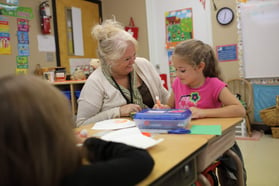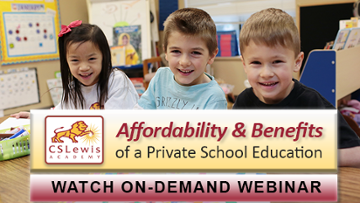This blog was originally published in spring, 2019. We thought it was very appropriate to republish now. We are proud at how our teachers have been able to respond to the Covid-19 crisis, partially due to their small class sizes. The small classes will also allow for additional flexibility when we return to school.
On my daughter’s first day of kindergarten I called my mother to report on her granddaughter’s first day. “So?” she asked, “How big is her class?” My mother, a veteran public school teacher for over 30 years, knew that this was one of the major reasons we had chosen private schooling for our daughter.
“Eight.”
“Eighteen?” She replied, surely she hadn’t heard me right.
“No, there are eight children in her class.” I replied.
“Wow!”
Small class sizes have blessed my daughter, enhancing her education and helping her grow. Here are some benefits of small class sizes:
1. Student is Known
With small classes, each student is known by their teacher and classmates. At the end of the long day, my daughter’s teacher often gives me a big smile at pick-up time and shares something fun my daughter said during the day. She knows my daughter’s favorite color, favorite animal, and the names of every member of our family.
2. Individualized Instruction
With eight children in a class a teacher is able to customize instruction to the student. The teacher, knowing each student, can give some customization to each lesson to fit the interests and abilities of each child.
3. Good Communication with Parents
Parent-teacher communication can be very challenging, and when a teacher is responsible for 25 or more children, it becomes nearly impossible. With smaller classes my daughter’s teacher has the ability to let me know of any problems or concerns right away. I know what is going on in the classroom and on the playground and I am equipped to work hand-in-hand with my child’s teacher to support my daughter’s learning.
4. Less time wasted on behavior management
This one is simple math. 25 > 8. Quieting a classroom or transitioning between activities always takes time. In a large classroom, it can take 10 minutes to make the transition (more time in younger grades!). With smaller class sizes, the transition is finished in a few minutes and the class can move on to new learning.\
5. Field Trips!
Taking a class of eight children on an educational trip outside the classroom (who doesn’t love field trips!) can be as simple as two approved parent volunteers with minivans or SUVs! Small class sizes offer a chance for children to dig in to their cultural and educational experiences without the challenges that come with large classes.
6. Birthday Parties
Ok parents, I know you are with me on this one. Most schools have a policy that children must invite all classmates to birthday parties. In traditional classes, you are quickly looking at 50+ attendees for little Eddy’s birthday. In a small class, inviting the whole crew is much less of an ordeal, and they are more likely to come! This year we were able to bring the party to our daughter’s classroom. A dozen brownies, some birthday-themed science experiments, and we had a hit!
7. Hands-on Learning
With a smaller class each child has a chance to get their hands dirty with their education (sometimes literally!). Experiments, crafts, and manipulatives can be handled by each child. For kinesthetic learners, this opportunity is essential!
8. Self-Expression
Have you ever tried to speak up in a room with 30 people all bursting to share their own comments? In a small class, each child is able to share their thoughts and ideas. This encourages deep thinking and meta-cognition. The voice of each child is valued and heard.
9. A Class of Friends
I can name each of my child’s classmates, and many of their unique personality traits. Why? Because my daughter just loves to tell me about her friends. She knows each classmate well and they all care for each other. The class is too small for cliques to form, a spirit of inclusivity is encouraged.
10. Better Results
Many studies have shown that small class sizes lead to better learning. The Center for Public Education published this study which indicated that smaller class sizes lead to better student outcomes, especially in underrepresented populations. The NEA has also produced a study showing that small class sizes improve high school graduation rates.
The benefits of small classes are easy to see. For our family, putting our daughter in a small class has been an essential key to her foundational education.
.png?width=209&name=CSLA%20Logo%20Alt%20(1).png)

